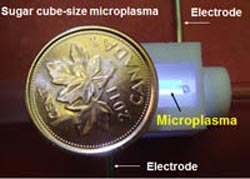Autonomous energy-scavenging micro devices will test water quality, monitor bridges, more

Battery-operated sugar-cube-size microplasma: the microplasma fits inside the letter "A" of a one-cent coin (for scale); sample is introduced into the chamber to the right.<br>
Researchers at the University of Waterloo in Ontario are using optics and photonics in their quest to “bring the lab to the sample,” said lead researcher Vassili Karanassios of the Department of Chemistry and of the university's Institute for Nanotechnology (WIN) A major aspect of his team's solution, reported in a conference and publication by SPIE, the international society for optics and photonics, is scavenging energy from various sources to power instruments at the sample site.
While energy harvesting utilizes sources such as wind power, energy scavenging involves re-using discarded energy, such as the electric light that runs a calculator, Karanassios said.
The team is incorporating wake-up systems in the devices to support energy autonomy, the ability to be powered as needed without an external source, without losing selectivity, the ability to gather and accurately analyze relevant data.
An important feature of his lab's approach is the integration of several features of full-scale laboratory instruments.
“People have experimented with sensors and with lab-on-a-chip devices for a long time,” Karanassios said. “But taking an entire instrument to the field in a hand-held device is new. Not many research groups have the expertise to integrate it all, to go from the sensor level to the micro-instrument level.”
The team is also working to reduce the power required for miniature instruments that perform optical emission spectrometry — using light to generate the spectral patterns that are intrinsically unique to materials — with very small samples. The resulting spectral “signature” is used to identify what is in the sample, for example, in on-site monitoring of water quality.
Among power source optics, sunlight is one obvious answer, Karanassios said, but limited by clouds and brief daylight in some regions. Additional possible sources and applications for energy scavenging are:
Plugging in to human body heat, unobtrusively scavenging energy in the form of otherwise-wasted heat generated by a person while walking, to power instruments for testing water quality or wearable biomedical monitors.
Harnessing animal body heat, to recharge implanted tracking devices. “When tagging and tracking animals in the wild, you do not want to have to catch the same animal one more time just to replace the battery that powers its sensors,” Karanassios noted.
Charging up a bridge sensor using mechanical energy generated in a spring-loaded device in the road, activated by vehicles crossing the bridge.
Because smaller sensors and instruments require less power, Karanassios' lab is working toward “shirt-pocket size” micro-instruments that eventually will deliver performance comparable to full-size lab versions.
They have experimented with a device the size of sugar cube that can be used along with a portable spectrometer for rapid screening of environmental contaminants, using spectral lines generated by wavelengths in the visible light and ultraviolet regions.
A paper detailing the work by Karanassios and Waterloo colleagues Donghyun Lee and Gurjit Dulai was published 28 May in the SPIE Digital Library, and presented in a conference on Energy Harvesting and Storage at SPIE Defense, Security, and Sensing (DSS) last month in Baltimore. Titled “Survey of energy harvesting and energy scavenging approaches for on-site powering of wireless sensor- and microinstrument-networks,” the paper is available via open access through 31 August 2013.
Karanassios also described the work in a video interview with the SPIE Newsroom, viewable at http://spie.org/x94092.xml (5:58).
SPIE is the international society for optics and photonics, a not-for-profit organization founded in 1955 to advance light-based technologies. The Society serves nearly 235,000 constituents from approximately 155 countries, offering conferences, continuing education, books, journals, and a digital library in support of interdisciplinary information exchange, professional networking, and patent precedent. SPIE provided over $3.2 million in support of education and outreach programs in 2012.
Media contact:
Amy Nelson
Public Relations Manager, SPIE
+1 360 685 5478
amy@spie.org
@SPIEtweets
Media Contact
More Information:
http://www.sie.orgAll latest news from the category: Interdisciplinary Research
News and developments from the field of interdisciplinary research.
Among other topics, you can find stimulating reports and articles related to microsystems, emotions research, futures research and stratospheric research.
Newest articles

NASA: Mystery of life’s handedness deepens
The mystery of why life uses molecules with specific orientations has deepened with a NASA-funded discovery that RNA — a key molecule thought to have potentially held the instructions for…

What are the effects of historic lithium mining on water quality?
Study reveals low levels of common contaminants but high levels of other elements in waters associated with an abandoned lithium mine. Lithium ore and mining waste from a historic lithium…

Quantum-inspired design boosts efficiency of heat-to-electricity conversion
Rice engineers take unconventional route to improving thermophotovoltaic systems. Researchers at Rice University have found a new way to improve a key element of thermophotovoltaic (TPV) systems, which convert heat…



